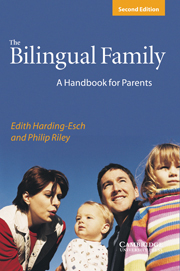Book contents
- Frontmatter
- Contents
- The authors
- Preface
- Part I A survey of the issues
- 1 Children and language
- 2 What is bilingualism?
- 3 Some things you should know about being bilingual
- 4 The development of the bilingual child
- 5 What will influence your decision whether to bring up your children as bilinguals?
- Part II Case studies: a number of bilingual families, and how they did it
- Part III An alphabetical reference guide
- Quotations
- Recommended resources
- Bibliography
- References
- Index
1 - Children and language
Published online by Cambridge University Press: 29 March 2010
- Frontmatter
- Contents
- The authors
- Preface
- Part I A survey of the issues
- 1 Children and language
- 2 What is bilingualism?
- 3 Some things you should know about being bilingual
- 4 The development of the bilingual child
- 5 What will influence your decision whether to bring up your children as bilinguals?
- Part II Case studies: a number of bilingual families, and how they did it
- Part III An alphabetical reference guide
- Quotations
- Recommended resources
- Bibliography
- References
- Index
Summary
What do children use language for?
In this section, we will be looking at the various stages that all children go through when they start talking. However, it is important to remember that we cannot see what is actually going on inside a child's head, so that despite the intense scrutiny that has been made in recent years of the ways in which children acquire language, much of the mystery remains. This is one reason why we will concentrate on what children actually do with language, since that can be observed and studied by an outsider. A second reason is that it is of far greater relevance to their relationships with their parents than most technical studies, which tend to deal with such topics as the order in which certain fine points of grammar are acquired, or the connection between language and the physiology of the brain. For example, it is possible to analyse in great detail how a child gradually acquires the complex grammar of negation, but when Eliot (2 yrs 1 mth) says ‘No Teletubbies!’ his mother needs to know whether he wants her to change TV channels or not.
Building up relationships
– Morning.
– Morning.
– Bit nippy, isn't it?
– Yes. Really nippy.
– Oh well.
– Yes, well. See you.
– See you.
We spend much of our lives building up and maintaining social relationships by means of rituals of this kind. If we look at the actual content of such exchanges, at what is actually said, we find that they are almost totally bereft of meaning.
- Type
- Chapter
- Information
- The Bilingual FamilyA Handbook for Parents, pp. 3 - 21Publisher: Cambridge University PressPrint publication year: 2003



